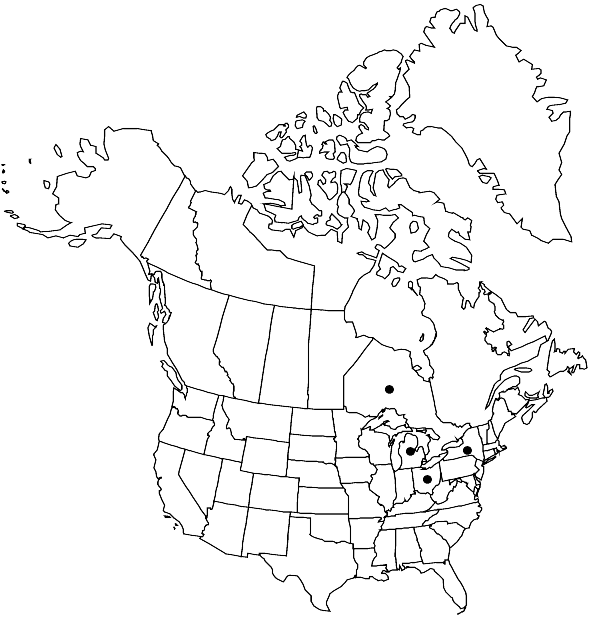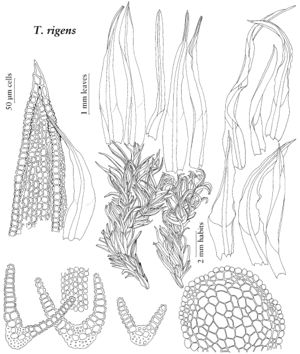Difference between revisions of "Tortella rigens"
Acta. Phytogeogr. Suec. 20: 197, figs. 15, 16. 1946,.
FNA>Volume Importer |
imported>Volume Importer |
||
| (6 intermediate revisions by 2 users not shown) | |||
| Line 21: | Line 21: | ||
|elevation=mostly low elevations (0-100 m) | |elevation=mostly low elevations (0-100 m) | ||
|distribution=Ont.;Mich.;N.Y.;Ohio;Europe. | |distribution=Ont.;Mich.;N.Y.;Ohio;Europe. | ||
| − | |discussion=<p>Tortella rigens is known in Europe from the alvars of the circum-Baltic states and central Europe. In North America, alvars appear confined to substrates of Ordovician and Silurian limestones and dolomites, being areas of exposed rock adjacent to bodies of water. The exposures occur around the Great Lakes and St. Lawrence River and associated lakes, such as Lake Simcoe in Ontario and Lake Champlain in New York and Vermont. The epithet refers to the somewhat rigid character of the leaves (but not as rigid as in T. fragilis). The proximal stem leaves when dry, however, may be as rigidly erect and straight as those of T. fragilis. Tortella rigens may have an adaxial epidermis in the proximal part of the leaf and the adaxial stereid layer is less exposed (usually by two stereid cells), hence there is a somewhat more narrow groove or channel running the length of the leaf. Tortella inclinata var. inclinata is regularly cucullate whereas T. rigens is distinctly cucullate usually only in the smallest leaves or on the smallest stems, or in the first whorl of leaves at the stem base. The leaf apices of T. inclinata var. inclinata may be acute to narrowly so, the distal laminal cells, however, are only 10–12 µm, while in section, the leaves are not 2-stratose juxtacostally, the leaves keeled beside the costa and broadly incurved distally. Tortella rigens has 2-stratose cells juxtacostally in the median portion of the leaf, and therefore the laminae spread out in a broadly concave leaf cross section, the distal cells 14 µm or more in width. Although T. rigens was not recorded as part of the Canadian flora by R. R. Ireland et al. (1987), it does appear in the most recent checklist of North American mosses (L. E. Anderson et al. 1990). The species has previously been reported from Colorado by W. A. Weber (1973), but several specimens collected and determined as that species can be assigned to other species, mainly T. alpicola and depauperate plants of T. fragilis. The cells sizes are undoubtedly large in T. rigens, to 14 or rarely 17 µm, but sizes to 14 µm correlated with reduced apical propagula can be demonstrated in T. fragilis.</p> | + | |discussion=<p><i>Tortella rigens</i> is known in Europe from the alvars of the circum-Baltic states and central Europe. In North America, alvars appear confined to substrates of Ordovician and Silurian limestones and dolomites, being areas of exposed rock adjacent to bodies of water. The exposures occur around the Great Lakes and St. Lawrence River and associated lakes, such as Lake Simcoe in Ontario and Lake Champlain in New York and Vermont. The epithet refers to the somewhat rigid character of the leaves (but not as rigid as in <i>T. fragilis</i>). The proximal stem leaves when dry, however, may be as rigidly erect and straight as those of <i>T. fragilis</i>. <i>Tortella rigens</i> may have an adaxial epidermis in the proximal part of the leaf and the adaxial stereid layer is less exposed (usually by two stereid cells), hence there is a somewhat more narrow groove or channel running the length of the leaf. <i>Tortella inclinata </i>var.<i> inclinata</i> is regularly cucullate whereas <i>T. rigens</i> is distinctly cucullate usually only in the smallest leaves or on the smallest stems, or in the first whorl of leaves at the stem base. The leaf apices of <i>T. inclinata </i>var.<i> inclinata</i> may be acute to narrowly so, the distal laminal cells, however, are only 10–12 µm, while in section, the leaves are not 2-stratose juxtacostally, the leaves keeled beside the costa and broadly incurved distally. <i>Tortella rigens</i> has 2-stratose cells juxtacostally in the median portion of the leaf, and therefore the laminae spread out in a broadly concave leaf cross section, the distal cells 14 µm or more in width. Although <i>T. rigens</i> was not recorded as part of the Canadian flora by R. R. Ireland et al. (1987), it does appear in the most recent checklist of North American mosses (L. E. Anderson et al. 1990). The species has previously been reported from Colorado by W. A. Weber (1973), but several specimens collected and determined as that species can be assigned to other species, mainly <i>T. alpicola</i> and depauperate plants of <i>T. fragilis</i>. The cells sizes are undoubtedly large in <i>T. rigens</i>, to 14 or rarely 17 µm, but sizes to 14 µm correlated with reduced apical propagula can be demonstrated in <i>T. fragilis</i>.</p> |
|tables= | |tables= | ||
|references= | |references= | ||
| Line 30: | Line 30: | ||
-->{{#Taxon: | -->{{#Taxon: | ||
name=Tortella rigens | name=Tortella rigens | ||
| − | |||
|authority=Albertson | |authority=Albertson | ||
|rank=species | |rank=species | ||
| Line 44: | Line 43: | ||
|publication year= | |publication year= | ||
|special status= | |special status= | ||
| − | |source xml=https:// | + | |source xml=https://bitbucket.org/aafc-mbb/fna-data-curation/src/2e0870ddd59836b60bcf96646a41e87ea5a5943a/coarse_grained_fna_xml/V27/V27_733.xml |
|subfamily=Pottiaceae subfam. Trichostomoideae | |subfamily=Pottiaceae subfam. Trichostomoideae | ||
|genus=Tortella | |genus=Tortella | ||
Latest revision as of 21:28, 5 November 2020
Plants firm, somewhat rigid, occasionally brittle when dry, in low, dense, dark brown to black to emerald-green tufts, compact, elongate, not rosulate. Stem 1–3 cm, rarely to 4 cm, densely foliose, leaf bases not evident between the leaves, central strand absent, tomentum rufous, dense, visible between the leaf bases especially along the lower stem. Stem leaves firm, somewhat rigid, stiffly erect, especially proximal leaves, to loosely twisted and moderately contorted when dry, erect and somewhat spreading when moist, gradually larger and more crowded toward the stem tips, distal-most leaves usually more spreading than the erect leaves or leaf bases proximally; leaf shape variable within clumps and on the same stem: short stems with leaves short, ovate-lanceolate, margins inwardly tapering to acute apices, longer stems with longer, more narrowly lanceolate leaves with more acuminate apices, the proximal leaves frequently narrowly lanceolate, distal leaves ovate or broadly ovate-lanceolate, generally narrowing gradually, but often some distal-most leaves with an abrupt narrowing with parallel sides in the distal quarter, leaf tips fragile, the older ones usually eroded; deeply concave to canaliculate-tubulose in longer leaves, 1.5–3(–4) mm; base undifferentiated in shape to broadly ovate proximally narrowing gradually or abruptly to the lanceolate distal lamina; margins variously plane, erect, to incurved, infrequently undulate in some leaves, apex fragile, acute to acuminate, abruptly ending before a sharp apiculus or narrowly acute and confluent with a conical, nearly mucronate apiculus; in shorter leaves naviculate to nearly cucullate, distinctly cucullate in the awl-shaped youngest leaves arising from the stem apex; longer, narrow leaves with erect to broadly incurved margins extending to the leaf apex; costa short-excurrent into a sharp, narrow, denticulate or smoothly conical mucro of 1–5(–10) cells, adaxial surface covered by quadrate, papillose laminal cells except for a narrow groove of elongate (8:1) smooth cells continuous throughout length of the leaf, in cross section, adaxial epidermal cells interrupted in the center, exposing the adaxial stereid layer by about two cells; proximal laminal cells abruptly differentiated from distal cells, yellow-hyaline, elongate, 6–8:1, firm to laxly thin-walled, smooth; marginal angle of differentiated cells steep due to the quadrate laminal cells extending juxtacostally far down into the proximal cell region, with a marginal row of firm to thin-walled, quadrate to short-rectangular smooth cells extending a short way up the lamina or to mid-leaf; distal laminal cells frequently 2-stratose on one or both laminae juxtacostally or extending marginward as one to two pairs of cells, but never extending to the margins even in longer leaves with narrowed apices, rounded-quadrate or hexagonal, with slightly thickened walls, (12–)14(–17) µm wide, strongly papillose, areolation more or less distinct, differentiated distal marginal cells absent except in longer leaves possessing a somewhat differentiated and deciduous apex, these having obscure (due to erosion) to distinct thicker-walled, less papillose to smooth, elongate marginal cells. Specialized asexual reproduction apparently by means of fragile leaf tips in the longer leaves. Sexual condition apparently dioicous: only sterile and perichaetiate plants seen. Perichaetia terminal, leaves long-lanceolate, costa excurrent into a long awn or subula. Sporophytes unknown.
Habitat: Forming shaglike patches on limestone alvar pavement (but not limestone bluffs, boulders and other calcareous landforms)
Elevation: mostly low elevations (0-100 m)
Distribution

Ont., Mich., N.Y., Ohio, Europe.
Discussion
Tortella rigens is known in Europe from the alvars of the circum-Baltic states and central Europe. In North America, alvars appear confined to substrates of Ordovician and Silurian limestones and dolomites, being areas of exposed rock adjacent to bodies of water. The exposures occur around the Great Lakes and St. Lawrence River and associated lakes, such as Lake Simcoe in Ontario and Lake Champlain in New York and Vermont. The epithet refers to the somewhat rigid character of the leaves (but not as rigid as in T. fragilis). The proximal stem leaves when dry, however, may be as rigidly erect and straight as those of T. fragilis. Tortella rigens may have an adaxial epidermis in the proximal part of the leaf and the adaxial stereid layer is less exposed (usually by two stereid cells), hence there is a somewhat more narrow groove or channel running the length of the leaf. Tortella inclinata var. inclinata is regularly cucullate whereas T. rigens is distinctly cucullate usually only in the smallest leaves or on the smallest stems, or in the first whorl of leaves at the stem base. The leaf apices of T. inclinata var. inclinata may be acute to narrowly so, the distal laminal cells, however, are only 10–12 µm, while in section, the leaves are not 2-stratose juxtacostally, the leaves keeled beside the costa and broadly incurved distally. Tortella rigens has 2-stratose cells juxtacostally in the median portion of the leaf, and therefore the laminae spread out in a broadly concave leaf cross section, the distal cells 14 µm or more in width. Although T. rigens was not recorded as part of the Canadian flora by R. R. Ireland et al. (1987), it does appear in the most recent checklist of North American mosses (L. E. Anderson et al. 1990). The species has previously been reported from Colorado by W. A. Weber (1973), but several specimens collected and determined as that species can be assigned to other species, mainly T. alpicola and depauperate plants of T. fragilis. The cells sizes are undoubtedly large in T. rigens, to 14 or rarely 17 µm, but sizes to 14 µm correlated with reduced apical propagula can be demonstrated in T. fragilis.
Selected References
None.
